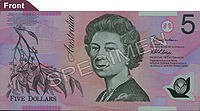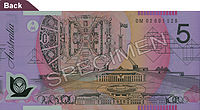- Australian five-dollar note
-
Five Dollars (Australia) Value: 5 Australian dollars Width: 130 mm Height: 65 mm Security Features: Window, Shadow image Paper Type: Polymer Years of Printing: 1992, 1994-98, 2001-03, 2005-2008[1] Obverse 
Design: Queen Elizabeth II Designer: Bruce Stewart Design Date: 24 April 1995 Reverse 
Design: Parliament House, Canberra Designer: Bruce Stewart Design Date: 24 April 1994 The Australian 5 dollar note was first issued in 1967, one year after the currency was changed from the Australian pound to the Australian dollar on 14 February 1966. It was a new denomination, as the pound system had no £2½, with a new mauve colouration.
There have been four different issues of this denomination:
- a paper note which had a gradient of mauve, with a distinct black overprint.
- The first polymer issue, which can be recognised for its distinct mauve colouration and numeral font, was first issued in pale mauve (1992). It was soon discovered that ultra-violet light degraded the ink bond and that a note in circulation for any moderate period of time could have elements scratched off with a fingernail, for example.
- In 1995, a second polymer issue was created, distinguishable by its deeper shade and different font for the numeral.
- A federation commemorative was issued in 2001 for that year only. Notes featured Sir Henry Parkes on the obverse and Catherine Helen Spence on the reverse.
Contents
Statistics
According to Reserve Bank statistics, at the end of June 2006 there was a net value of $572 million in $5 notes in circulation, with a 1.5% cash value of all issued currency. Actual banknotes in circulation account for 13.3% of all denominations, or 114 million banknotes.[2]
Since the start of issuance there have been sixteen signature combinations, of which the 1967 issue is of the greatest value, issued for two years only; and the 1990 Fraser/Higgens being issued for less than a year.
From 1967 to 1974, the main title identifying the country was "Commonwealth of Australia" and there were 195,504,000 notes issued in its life. This was subsequently changed to "Australia" until the end of the issuance of paper currency for this denomination in 1992 with 978,068,318 of these notes being issued.
Design
On the latest 5 dollar note Queen Elizabeth II is on the front of the 5 dollar note along with eucalyptus leaves. There is a number 5 in the right hand corner of both sides. There is Australia written to the left of the queen. The parliament house is on the back of the 5 dollar note. In 2001, notes featured Sir Henry Parkes on the obverse and Catherine Helen Spence on the reverse.
Security features
The paper design included a watermark in the white field of Captain james cook , the watermark was also used in the last issue of pound banknotes. A metallic strip, first near the centre of the note, then from 1976 moved to the left side on the obverse of the note.
The polymer issue includes a shadow image of the Australian coat of arms which is visible under other printing when the note is held up to light, a pointed star with four points on the obverse and three on the reverse that come together under light, a clear window that has a eucalyptus leaf showing, and raised print and micro printing of the denomination name.
Some features of the banknote glow under UV light, these features include the serial number and a square patch on the reverse of the note. There is also raised printing around the portraits and major design elemnents of the note which can be felt by rubbing the finger or fingernail against it.[3]
Other issues
-
Federation commemorative obverse featuring Henry Parkes
-
Federation commemorative reverse featuring Catherine Helen Spence
-
1967 paper note obverse featuring Joseph Banks
-
1967 paper note reverse featuring Caroline Chisholm
References
- ^ http://www.rba.gov.au/banknotes/collecting/serial-info/index.html
- ^ Reserve bank statistics 2004/2005
- ^ The Australian $5 banknote Published by the Reserve Bank of Australia. Retrieved 19 November 2011.
- Ian W. Pitt, ed (2000). Renniks Australian Coin and Banknote Values (19th ed. ed.). Chippendale, N.S.W.: Renniks Publications. pp. 171–172. ISBN 0-9585574-4-6.
Australian currency Topics Mints Coins - 1¢
- 2¢
- 5¢
- 10¢
- 20¢
- 50¢ round
- 50¢
- $1
- $2
- Pre-£ coins
- Coins of the £
- Coins of the $
- Commemorative coins
Banknotes Historic Categories:- Banknotes of Australia
- 1967 introductions
Wikimedia Foundation. 2010.




